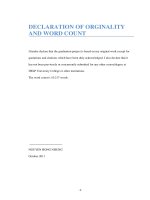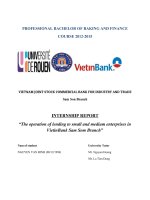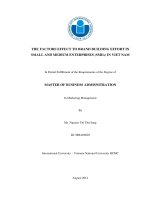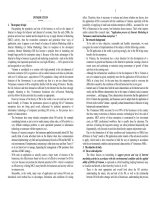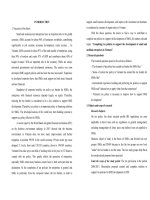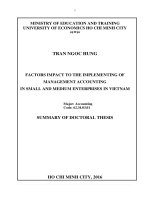The factors effect to brand building effort in small and medium enterprises (SMEs) in viet nam
Bạn đang xem bản rút gọn của tài liệu. Xem và tải ngay bản đầy đủ của tài liệu tại đây (912.64 KB, 70 trang )
THE FACTORS EFFECT TO BRAND BUILDING EFFORT IN
SMALL AND MEDIUM ENTERPRISES (SMEs) IN VIET NAM
In Partial Fulfillment of the Requirements of the Degree of
MASTER OF BUSINESS ADMISNITRATION
In Marketing Management
By
Ms. Nguyen Thi Thu Sang
ID: MBA06028
International University – Vietnam National University HCMC
August 2014
THE FACTORS EFFECT TO BRAND BUILDING EFFORT IN SMALL AND
MEDIUM ENTERPRISES (SMEs) IN VIET NAM
In Partial Fulfillment of the Requirements of the Degree of
MASTER OF BUSINESS ADMINISTRATION
In Marketing Management
By
Ms. Nguyen Thi Thu Sang
ID: MBA06028
International University - Vietnam National University HCMC
April 2014
Under the guidance and approval of the committee, and approved by all its members,
this thesis has been accepted in partial fulfillment of the requirements for the degree.
Approved:
---------------------------------------------Chairperson
---------------------------------------------Committee member
---------------------------------------------Committee member
--------------------------------------------Committee member
--------------------------------------------Committee member
--------------------------------------------Committee member
Acknowledge
I would like to express my heartfelt gratitude to my Supervisor, Dr. Le Nguyen Hau
for his patient and support to suggest guidelines, development orientation and
encouragement, reading and commenting on this thesis.
Secondly, I would like to send my grateful to Dr. Phan Trieu Anh, Dr. Ho Thi Bich
Van and Dr. Pham Hong Hoa – members of the proposal examination for their
valuable comments and suggestions.
Thirdly, I would like to thanks to Association of Small and Medium Enterprises in
Ho Chi Minh City for their help about contacting and connecting to SMEs in data
collection.
Lastly, I am thankful to my family, my friends and those who supported during my
working on the thesis.
i
Plagiarism Statements
I would like to declare that, apart from the acknowledged references, this
thesis either does not use language, ideas, or other original material from anyone; or
has not been previously submitted to any other educational and research programs or
institutions. I fully understand that any writings in this thesis contradicted to the
above statement will automatically lead to the rejection from the MBA program at
the International University – Vietnam National University Hochiminh City.
ii
Copyright Statement
This copy of the thesis has been supplied on condition that anyone who
consults it is understood to recognize that its copyright rests with its author and that
no quotation from the thesis and no information derived from it may be published
without the author’s prior consent.
© Nguyen Thi Thu Sang/ MBA06028/ 2014
iii
Table of Contents
Acknowledgement ...................................................................................................i
Plagiarism Statements ............................................................................................ii
Copyright Statement ...............................................................................................iii
List of Table ........................................................................................................... viii
List of Figures ..........................................................................................................x
Abstract ....................................................................................................................xi
Chapter 1: INTRODUCTION ...............................................................................1
1.1 Background .........................................................................................................1
1.2 Problem Statement ..............................................................................................2
1.3 Research Question ...............................................................................................3
1.4 Research Hypothesis ...........................................................................................3
1.5 Research Objectives ............................................................................................4
1.6 Implication of the Research ................................................................................4
1.7 Research Scope ...................................................................................................5
1.8 Structure of the thesis ..........................................................................................5
Chapter 2: LITERATURE REVIEW ...................................................................7
2.1 Definitions of Concepts ......................................................................................7
2.1.1 Small and Medium Enterprises ...................................................................7
2.1.2 Brand ...........................................................................................................8
2.1.3 Corporate Brand ..........................................................................................8
iv
2.1.4 Brand Management .....................................................................................9
2.2.5
The importance of Brand .........................................................................11
2.2 Brand building in SMEs ......................................................................................11
2.2.1 Role of building strong brand in SMEs ......................................................11
2.2.2
Factors effect to brand building effort .....................................................12
2.2.2.1 Commitment of Owners ........................................................................12
2.2.2.2 Available of Resources ..........................................................................12
2.2.2.3 Culture of Organization .........................................................................12
2.2.2.4 Strategic Vision .....................................................................................13
2.2.2.5 Perceived Image ....................................................................................13
2.3 Conceptual Model Framework .......................................................................13
2.4 Brand Management Issues faced in SMEs .....................................................15
2.4.2
Narrow Interpretation on Brand Management .........................................15
2.4.3
Lack up Resource and Time .....................................................................16
2.4.4
Less attention on Brand building in SMEs ..............................................16
Chapter 3: RESEARCH METHODOLOGY .......................................................18
3.1 Research Design ..................................................................................................18
3.2 Sampling .............................................................................................................18
3.3 Data Collection ....................................................................................................19
3.4 Data Analysis ......................................................................................................20
3.4.1 Descriptive Statistic .....................................................................................20
v
3.4.2 Reliability Statistic ......................................................................................20
3.4.3 Exploratory Factor Analysis ........................................................................20
Chapter 4: DATA ANALYSIS AND RESULTS ..................................................22
4.1 Sample Demographics ........................................................................................22
4.2 Descriptive Statistics ...........................................................................................24
4.2.1
Attitude ..........................................................................................................24
4.2.2
Brand Building Effort ...................................................................................25
4.3 Reliability Test ....................................................................................................27
4.3.1 Commitment of Owners ...................................................................................27
4.3.1
Availability of Resources ..............................................................................28
4.3.2
Culture of Organization .................................................................................29
4.3.3
Strategic Vision .............................................................................................29
4.3.4
Perceived Image ............................................................................................30
4.3.6 Brand Building Effort ......................................................................................31
4.4 Results of Exploratory Factor Analysis (EFA) .................................................32
4.4.1
Result of Factor Analysis each Independent Variables .................................32
4.4.2
Result of Factor Analysis Dependent Variable – Brand Building Effort ......36
4.5 Correlation Testing ............................................................................................38
4.6 Regression Analysis ..........................................................................................40
Chapter 5: DISCUSSION AND RECOMMENDATION ...................................43
5.1 Explore the attitude of SMEs owners .................................................................43
5.2 Brand Building Effort .........................................................................................44
vi
5.3 Recommendation for SMEs ................................................................................44
Chapter 6: CONCLUSION AND LIMITATION ................................................46
6.1 Conclusion ..........................................................................................................46
6.2 Limitation of the Study .......................................................................................47
REFERENCES ........................................................................................................48
APPENDIX ..............................................................................................................54
vii
List of Tables
Table 3.1: SME Definitions Used by Multilateral Institutions .................................18
Table 3.2: SME Definitions of Decree 56/2009/NĐ-CP ..........................................19
Table 3.3: Sample size ..............................................................................................19
Table 4.1: Demographic information ........................................................................22
Table 4.2: Attitude scores .........................................................................................24
Table 4.3: Action scores ............................................................................................25
Table 4.4: Cronbach’s Alpha of Commitment ..........................................................28
Table 4.5: Cronbach’s Alpha of Resources ...............................................................28
Table 4.6: Cronbach’s Alpha of Culture of Organization .........................................29
Table 4.7: Cronbach’s Alpha of Vision ....................................................................29
Table 4.8: Cronbach’s Alpha of Perceived Image ....................................................30
Table 4.9: Cronbach’s Alpha of Brand Building Effort ............................................31
Table 4.10: KMO and Bartlett's Test of Independent Variables ...............................33
Table 4.11: Total Variance Explained ......................................................................34
Table 4.12: Rotated Component Matrix of Independent Variables ..........................36
Table 4.13: KMO and Bartlett's Test of Dependent Variable ...................................36
Table 4.14: Total Variance Explained ......................................................................37
viii
Table 4.15: Component Matrix .................................................................................37
Table 4.16: Correlations ............................................................................................39
Table 4.17: Model Summary .....................................................................................40
Table 4.18: Coefficients ............................................................................................41
Table 4.19: Test of Homogeneity of Variances ........................................................42
ix
List of Figures
Figure 2.1: The conceptual research model ..............................................................15
x
Abstract
Brand concept has been discussed a lot in many big companies and
multinationals. However, in many SME companies, brand management receives little
or no attention in the daily run of affairs. Although the owners or director are the
ones to take the lead in this area, they either seldom have the time for it or are not
even aware of brand management as a concept. And because this concept is not
ingrained within such an SME, there are no other employees available to give it
sufficient attention.
The study attempt to explore the attitude of SMEs owners towards brand
building and aim to identify internal and external factor effect to brand building
effort then draw managerial implications for SMEs.
Based on the quantitative survey, the respondents were SMEs owners with
samples size of 162. SPSS software 20.0 was used to analyze the collected data. The
date was analyzed in five steps: the first step was Descriptive Statistic, the second
step was Reliability Statistic, the third step was Exploratory Factor Analysis and the
fourth step was Correlation Testing, the last step was Regression Analysis to show
the positive influence of all independent variables on dependent variables.
The result show that the most important dimension in effecting brand
building effort was Vision concerning to company business strategy, business
decision and leader’s impact. The other dimension was Commitment, Resources,
Culture and Perceived Image also affected important to brand building.
Keywords: Brand building, corporate brand, SMEs.
xi
xii
CHAPTER 1 - INTRODUCTION
1.1 Background
Nowadays, brand management plays an important role in marketing (Keller,
2003). A brand contains several elements, and can essentially be described as “an
identifiable product, service, person or place, which the buyer or user perceives as
relevant, unique, or sustainable added values which match their needs most closely
and provide more satisfaction” (De Chernatony, 2001). And famous brands have
played an important role in business customer decisions (Bendixen, Bukasa and
Abratt, 2004; Michell, King and Reas, 2001). For those reason, building strong
brands has become an important point for many companies since it produces a
number of marketing advantages and increases companies’s competitive strength
(Hoeffler and Keller, 2002). Thus, building strong brands not only increases their
visibility and credibility, but also distinguishes them from competitors, and acquires
more market share. The principal focus of branding is to build a successful brand that
can be distinguished from the competitor, be held in high esteem, and establish a
relationship with target customers (Aaker, 1996; Keller, 2003).
Brand management has been discussed a lot in many big companies and
multinationals, and branding also creates tremendous value for them. However, the
small and medium-sized enterprise group constitutes 95% percent of all businesses
which cannot be ignored (Thurik, R., Risseeuw, P. and Uhlaner, L. M., 2003).
Furthermore, too few researchers are focused on brand management issues in SMEs.
It is apparent that small and medium enterprises (SMEs) play a significant
role in the economic development of a country (Muhammad et al. 2010). In Viet
Nam recent year, SMEs have contributed important to growth and structure of the
1
economic, decrease unemployment, increase export turnover. Particular, SMEs
create a haft of millions labors yearly and devoted 40% of Gross Domestic Product
(GDP). The difference between large firms and SMEs can be described as the
physical dimensions (Hutchinson, K., Quinn, B. and Alexander, N., 2006). Although
the scope of SMEs is smaller than large enterprises, SMEs have their own features to
gain market share. Carson and Cromie (1989) also mentioned that SMEs have their
own particular characteristics and abilities which can largely determine their
marketing preoccupations and concerns, so it is universally and widely accepted that
small and medium businesses are not scaled-down big businesses.
In Vietnam, a trend of ignored brand management was plainly discernible in
recent time. Most of SMEs do not awareness of important in brand building in brand
management; it is evident that less company has brand management department. In
terms of brand managers, they are not only inexperienced, but also have no
knowledge of brand management; in terms of company management, there are two
missing from brand building and brand protection while brand protection must do in
first period of company established together with launching campaigns. On the other
hand, SMEs in Vietnam have general understandability about brand management.
For instance, company supplies the best product and quality to customer and they
expect to become loyalty with their clients, the question asked – is it enough to get
client’s loyalty when their competitors do also the same? Particularly with SMEs,
each company need to awareness their strength by bring “added value” to customers
and overcome other competitors.
1.2 Problem Statement
2
In the competitive environment, SMEs have to face the challenges not only
from the similar but also much stronger large firms. So, the brand strategy in SMEs
should be built upon and apply for internal and external challenges (Abimbola,
2001). Small business but SMEs know how to manage their brand it can become
well-known as large company.
By measurement effected of factors of commitment, resources, culture,
strategic vision and perceived image to brand building effort, SMEs can explore what
they will manage their brand? What role of brand management? What problem they
are facing with? And how to increasing brand awareness?
1.3 Research question
From the statement problem, the research raises the following research question:
What are the factors of commitment of owners, availability of resources, culture of
organization, strategic vision and perceived image effect to brand building effort in
SMEs?
1.4 Research hypothesis
H1: Factor of commitment of owners direct effect and positive associated to brand
building effort
H2: Factor of availability of resources direct effect and positive associated to brand
building effort
H3: Factor of culture of organization direct effect and positive associated to brand
building effort
3
H4: Factor of strategic vision direct effect and positive associated to brand building
effort
H5: Factor of perceived image direct effect and positive associated to brand building
effort
1.5 Research Objectives
Brand building is really necessary for those companies especially SMEs.
However, in Viet Nam many owners of SMEs usually ignore the importance of
brand and the benefits which derive from branding, or even worse they do not have a
brand. Given this situation, this research aims to:
-
To identify factors (internal and external) effect brand building effort in
SMEs
-
To draw managerial implications based on those results of the two above
objectives
1.6 Implication of the Research
This research describes the attitude of SMEs owners towards brand
management as well as the effort to build a strong brand. In fact, the study can
increase awareness of managers in SMEs who make business decision in company.
On the other hand, SMEs will recognize their visibility, credibility and competitive
strength.
The study explore that brand building do not only limited into advertising,
brand name and the logo in common but also identify internal and external factors
which effect to brand building effort in SMEs. From the research, the managerial
level can understand company’s demand to carry on brand strategy suitable in each
4
period. In economic situation now, SMEs can face with counterfeit problem, to
protection; company will create orientation for brand building.
1.7 Research Scope
Branding often considered as a large companies’ issue (Merrilees, 2007). The
concept of brand includes product branding and corporate branding. Most of large
companies have separate orientation development for two of them. However, in
SMEs which often less attention to branding will have same orientation between
product and corporate branding. In this study, the brand word will consider as
corporate branding or company branding.
Due to there is limited little research before. Thus, one limitation of this
research is that the study lacks theoretical rigour. Similarly, secondary data related to
SMEs is also limited. As the study is doing research 250 SMEs, the findings cannot
be considered representative of all SMEs.
Moreover, researchers’ understanding has limited in all of concept, so the
objective result may happen. That is also limitation of the research.
1.8 Structure of the thesis
Chapter 1: Introduction
This chapter makes a general introduction about research background, research
problem, research objectives, implication and scope of the research.
Chapter 2: Literature review
The literature review chapter focuses on related background concepts and theories of
brand building.
5
Chapter 3: Research Methodology
This chapter depicts research design, sampling methods, data collection, data
analysis methods.
Chapter 4: Data analysis and results
Data analysis chapter provides the progress of processing data after carrying out the
survey. Demographic information would be introduced in order to provide the
overview about population participant in the survey. Then descriptive statistic is
depicted through attitude and action to brand building effort. The next stage will be
analyzing Exploratory Factor Analysis and the last is correlation testing and
regression analysis.
Chapter 5: Discussion and findings
This chapter mainly focuses on discussion about the result through the survey.
Basing on the data results, the researcher solve research objective includes: explore
attitude of SMEs owners towards brand building and identify factors effect to brand
building effort. Then recommendation was given.
Chapter 6: Conclusions and Limitation
The last chapter depicts the conclusions and limitation for the SMEs towards brand
building concept.
6
CHAPTER 2 - LITERATURE REVIEW
2.1 Definitions of Concepts
2.1.1
Small and Medium Enterprises
SMEs include family businesses, startups, spin-offs and a variety of others
(Sadi and Henderson, 2010). SMEs can be classified by the number of employees,
annual turnover, and a combination of employee and turnover metrics (Hutchinson et
al., 2006)
The European definition of SME follows: "The category of micro, small and
medium-sized enterprises (SMEs) is made up of enterprises which employ fewer
than 250 persons and which have an annual turnover not exceeding 50 million euro,
and/or an annual balance sheet total not exceeding 43 million euro” (European
Commission, 2012).
According the Word Bank defined SME has at least 300
employees and has maximum turnover 15 million dollar, and the assets exceeding 15
million dollar. Moreover, definition of SMEs has not been easy as different countries
have different criteria for defining SMEs. Stokes and Wilson (2006), stated that the
“SME is defined as a small to medium enterprise managed by its owner(s) in a
personalized way with a relatively small share of the market in economic terms, and
having 10-49 employees”. Medium-sized have bigger than both micro and small
businesses in terms of operations, manpower capacity or number of employees,
structure, capital investment and size. According to Darren et al. (2009), they are the
businesses that employ up to 249 employees in UK, in European Union, they employ
up to 250 employees, in Australia, they employ up to 200 employees while in U.S.A,
they accommodate up to 500 employees. In Viet Nam, decree 56/2009/NĐ-CP of
government defines at most 300 employees.
7
One of the most popular definitions of SMEs is given by the American Small
Business Administration (SBA) as that business or firm which is independently
owned and operated; it is not dominant in its field and meets the criteria for the SME
business administration sponsored loans program (Arowomole, 2000).
2.1.2
Brand
Kotler and Keller (2006) acknowledge the American Marketing Association’s
definition of a brand as a “name, term, design, symbol, or any other feature that
identifies one seller's good or service as distinct from those of other sellers. The legal
term for brand is trademark. A brand may identify one item, a family of items, or all
items of that seller. If used for the firm as a whole, the preferred term is trade name”.
A brand is thus a product or service that adds dimensions which differentiate it in
some way from other products or services designed to satisfy the same need. These
differences may be functional, rational, or tangible – intangible – related to what the
brand represents.
Supporting Kotler and Keller’s view of a brand linking it to the tangibles of
the brand, Rosetti (2005) suggested in a presentation that a brand is a name, term,
sign, symbol, design or a combination of them, intended to identify the goods and
services of one seller or group of sellers and to differentiate them from those of the
competition.
Van den Heever (2000) is of the opinion that a brand is not a name, logo,
sign, symbol, advertisement or spokesperson. A brand is everything that
organizations want people, especially its target markets, to feel and believe about its
product and services.
2.1.3
Corporate Brand
8
Branding, especially corporate branding is often a radically new concept for
SMEs (Inskip, 2004). Corporate branding is defined as “a systematically planned and
implemented process of creating and maintaining a favorable image and
consequently a favorable reputation for the company as a whole by sending signals to
all stakeholders and by managing behavior, communication, and symbolism”
(Einwiller and Will, 2002). Corporate branding implies deserting product branding
with its narrow marketing-driven focus on tactical, functional processes. Corporate
branding is an attempt to accommodate these weaknesses. Product branding is based
on short-term advertising ideas, while corporate branding is based on a long-term
brand idea. Corporate branding also expands the parameters of differentiation by
enabling companies to use their rich heritage actively to create strong brands.
Corporate branding involves the whole organization and emphasizes the pivotal role
employees play if they are to succeed in the creation of a strong corporate brand.
Value and beliefs held by employees are key elements in the differentiation strategy.
According Schultz et al. (2005) define corporate branding is a “move towards
conceiving more integrated relationship between internal and external stakeholders
linking top management, employees, customers and other stakeholders”.
2.1.4
Brand Management
In practice of brand management, the main differences between large firms
and SMEs appear in building and managing brand equity. According David Aaker
(1996) brand management starts with developing a brand identity-the unique set of
brand associations that represent what the brand stands for and promises to
customers, an aspiration brand image. Aaker maintains that the identity should be
differentiating on some dimensions, suggest parity on others, resonate with
customers, drive brand-building programs, reflect the culture and strategy of the
9
business, and be credible. Credibility can be based on proof points, current assets or
programs or strategic initiatives, or investment in new or revitalized assets or
programs. Keller (2008) said strategic brand management process is all about
“building, measuring, and managing brand equity”; and he also points out that the
purpose of branding is to endue products and services with the strength of brand
equity.
A company’s brand management is integrated into the daily operation of the
company. Furthermore, a brand strategy and brand management implementation is
not a one-time effort, but a regular marketing strategy, and it should follow the
development of the enterprise (Keller, 1998)
2.1.5
The importance of Brand
Brands identify the source or marker of a product and allow consumers –
either individuals or organizations – to assign responsibility for its performance to a
particular manufacturer or distributor. Customers may evaluate the identical product
differently depending on how it is branded. They learn about brands through past
experiences with the product and its marketing program, finding out which brands
satisfy their needs and which do not. As consumer’s lives become more complicated,
rushed, and time starved, the ability of a brand to simplify decision making and
reduce risk is invaluable (Rajneesh Suri and Kent B. Monroe, 2003).
Brands also perform valuable functions for firms (Rita Clifton and John
Simmons, 2004; Rik Riezebos, 2003 and Paul Temporal, 2002). First, they simplify
product handling or tracing. Brands help to organize inventory and accounting
records. A brand also offers the firm legal protection for unique features or aspect of
the product (Constance E. Bagley, 2005; Judith Zaichkowsky, 2006; Maureen Morrin
10
and Jacob Jacoby, 2000). The brand name can be protected through registered
trademarks; manufacturing processes can be protected through patents; and packing
can be protected through copyrights and proprietary designs. These intellectual
property rights ensure that the firms can safely invest in the brand and reap the
benefits of a valuable asset.
Brand signal a certain level of quality so that satisfied buyers can easily
choose the product again (Tulin Erdem, 1998). Brand loyalty provides predictability
and security of demand for the firm, and it creates barriers to entry that make it
difficult for other firms to enter the market. Loyalty also can translate into customer
willingness to pay a higher price – often 20% to 25% more than competing brands
(Scott David, 2000; Mary W. Sullivan, 1998; D. C. Bello and M. B. Holbrook, 1996;
Adrian J. Slywotzky and Benson P. Shapiro, 1993). Although competitors may
duplicate manufacturing processes and product designs, they cannot easily match
lasting impressions left in the minds of individuals and organizations by years of
product experience and marketing activity. In this sense, branding can be a powerful
means to secure a competitive advantage (Naomi Klein, 2000).
2.2 Brand building in SMEs
2.2.1
Role of building strong brand in SMEs
Through comparing the brand management activities undertaken by high
versus low-performing SMEs, Berthon et al. (2008) find that high-performing SMEs
emphasize following 7 of 10 brand management practice (BMPs) than less successful
counterparts:
-
Brand delivers benefits customers truly desire
-
Brand stays relevant
11
